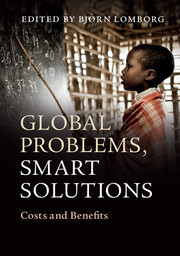Book contents
- Frontmatter
- Contents
- List of Figures
- List of Tables
- List of Contributors
- Acknowledgments
- Selected abbreviations and acronyms
- Introduction
- Part I The Solutions
- 1 Armed Conflicts
- 2 Ecosystems and Biodiversity
- 3 Chronic Disease
- 4 Climate Change
- 5 Education
- 6 Hunger and Malnutrition
- 7 Infectious Disease, Injury, and Reproductive Health
- 8 Natural Disasters
- 9 Population growth
- 10 Water and Sanitation
- 11 Corruption and Policy Reform
- 12 Trade Barriers and Subsidies
- Part II Ranking the Opportunities
- Conclusion: Making Your Own Prioritization
- Index
- References
12 - Trade Barriers and Subsidies
Published online by Cambridge University Press: 05 June 2014
- Frontmatter
- Contents
- List of Figures
- List of Tables
- List of Contributors
- Acknowledgments
- Selected abbreviations and acronyms
- Introduction
- Part I The Solutions
- 1 Armed Conflicts
- 2 Ecosystems and Biodiversity
- 3 Chronic Disease
- 4 Climate Change
- 5 Education
- 6 Hunger and Malnutrition
- 7 Infectious Disease, Injury, and Reproductive Health
- 8 Natural Disasters
- 9 Population growth
- 10 Water and Sanitation
- 11 Corruption and Policy Reform
- 12 Trade Barriers and Subsidies
- Part II Ranking the Opportunities
- Conclusion: Making Your Own Prioritization
- Index
- References
Summary
Opening economies to international trade and investment, and reducing price-distorting subsidies, can generate enormous economic and social benefits relative to the costs of adjustment to such policy reform. Numerous barriers to trade in goods, in some services, and in capital flows have been reduced considerably over the past three decades, but many remain, as do many farm subsidies. Such price-distorting policies harm most the economies imposing them, but the worst of them (in agriculture and textiles) are particularly harmful to the world's poorest people. Addressing this challenge would therefore also reduce poverty and thereby assist in meeting several of the other challenges identified in the Copenhagen Consensus project, including malnutrition, disease, poor education, and air pollution.
This chapter focuses on how costly those anti-poor trade policies are, and examines possible strategies to reduce remaining price-distorting measures. Four opportunities in particular are addressed. The most beneficial involves multilaterally completing the stalled Doha Development Agenda (DDA) of the WTO. If that continues to prove to be too difficult politically to bring to a conclusion in the near future, the other three opportunities considered here involve prospective subglobal regional integration agreements. One involves the proposed Trans-Pacific Partnership (TPP) among a subset of member countries of the Asia Pacific Economic Cooperation (APEC) grouping; another involves extending the free-trade area (FTA) among the ten-member Association of South East Asian Nations to include China, Japan, and Korea (ASEAN+3); and the third opportunity is an FTA among all APEC countries.
- Type
- Chapter
- Information
- Global Problems, Smart SolutionsCosts and Benefits, pp. 673 - 698Publisher: Cambridge University PressPrint publication year: 2013



